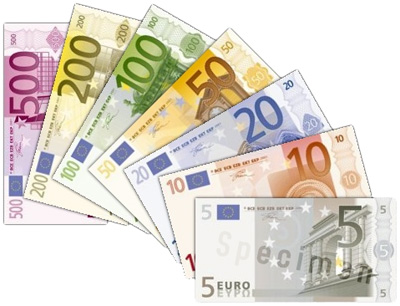Münzen und Scheine – Coins and Banknotes
The Euro is divided into 100 cents (sometimes referred to as euro-cents, especially when distinguishing them from other currencies). In official contexts the plural forms of euro and cent are spelled and pronounced without the s, and Germans follow that rule! All circulating coins have a common side showing the denomination or value, and a map in the background. For the denominations except the 1-, 2- and 5-cent coins that map only showed the 15 member states which were members when the Euro was introduced. Beginning in 2007, the old map is being replaced by a map of Europe also showing countries outside the Union like Norway. The 1-, 2- and 5-cent coins, however, keep their old design, showing a geographical map of Europe with the 15 member states of 2002. The coins also have a national side showing an image specifically chosen by the country that issued the coin.

Coins are issued in €2, €1, 50-cent, 20-cent, 10-cent, 5-cent, 2-cent, and 1-cent denominations.
Commemorative coins with €2 face value have been issued with changes to the design of the national side of the coin. These include both commonly issued coins, such as the €2 commemorative coin for the fiftieth anniversary of the signing of the Treaty of Rome, and nationally issued coins, such as the coin to commemorate the 2004 Summer Olympics issued by Greece. These coins are legal tender throughout the Eurozone.
The design for the banknotes have common designs on both sides. Notes are issued in €500, €200, €100, €50, €20, €10, €5. Each banknote has its own color and is dedicated to an artistic period of European architecture. The front of the note features windows or gateways while the back has bridges. Some of the highest denominations such as the €500 are not issued in all countries, though they remain legal tender throughout the Eurozone.



